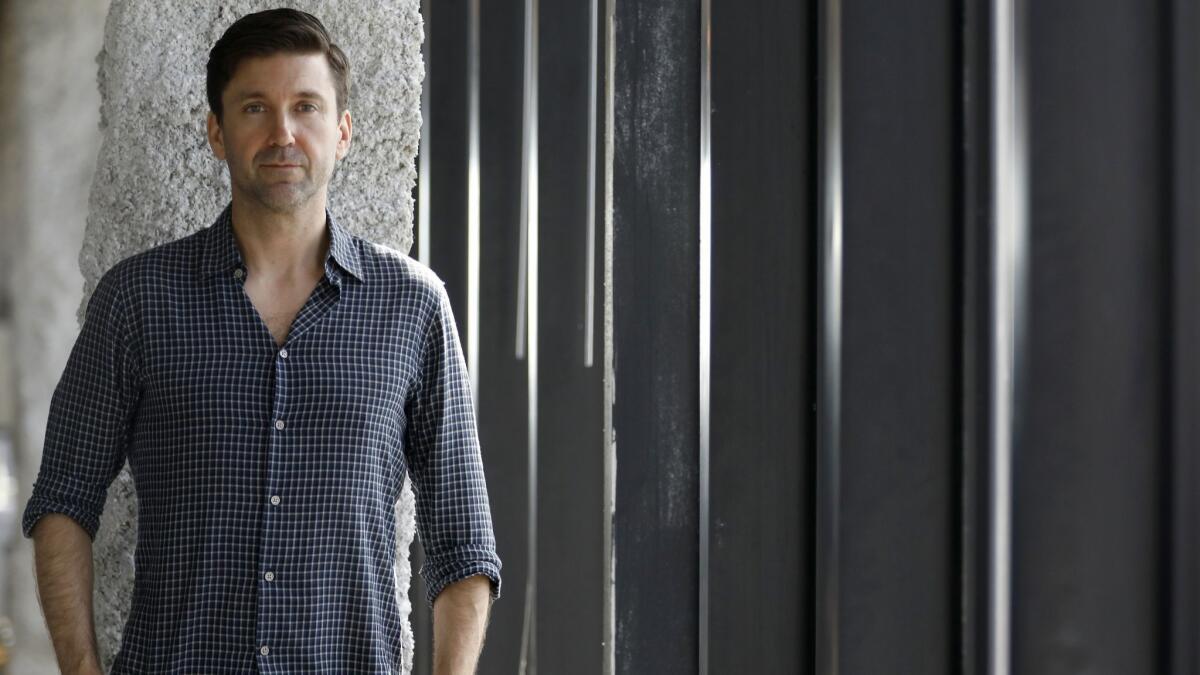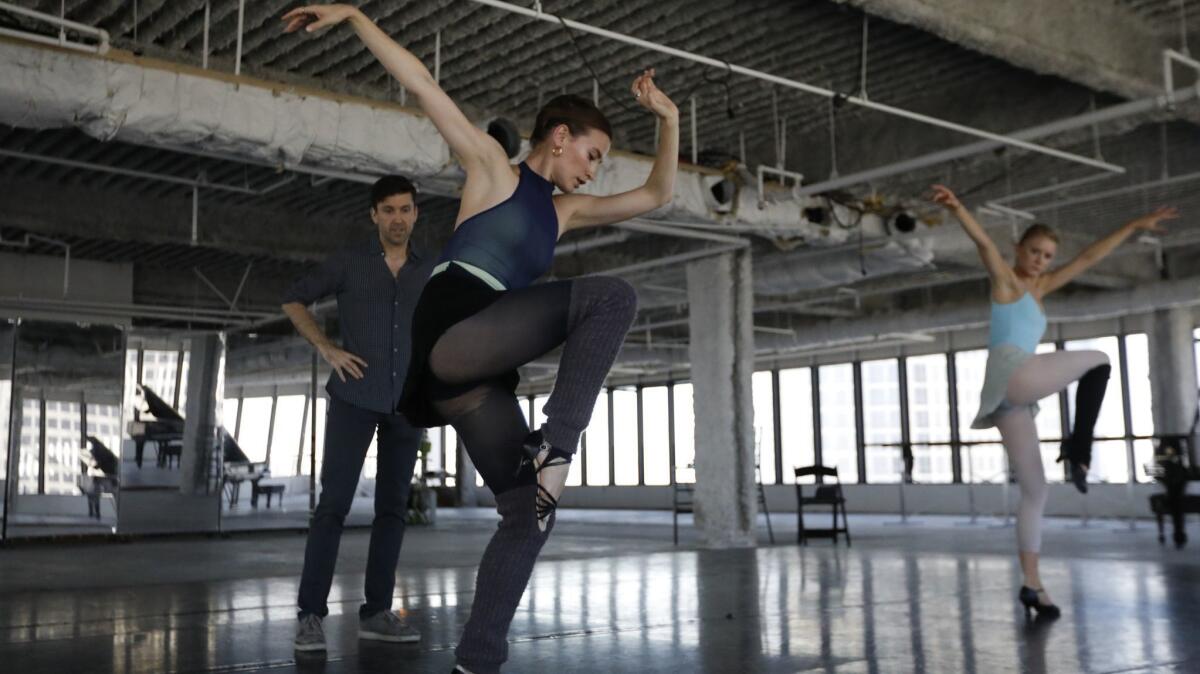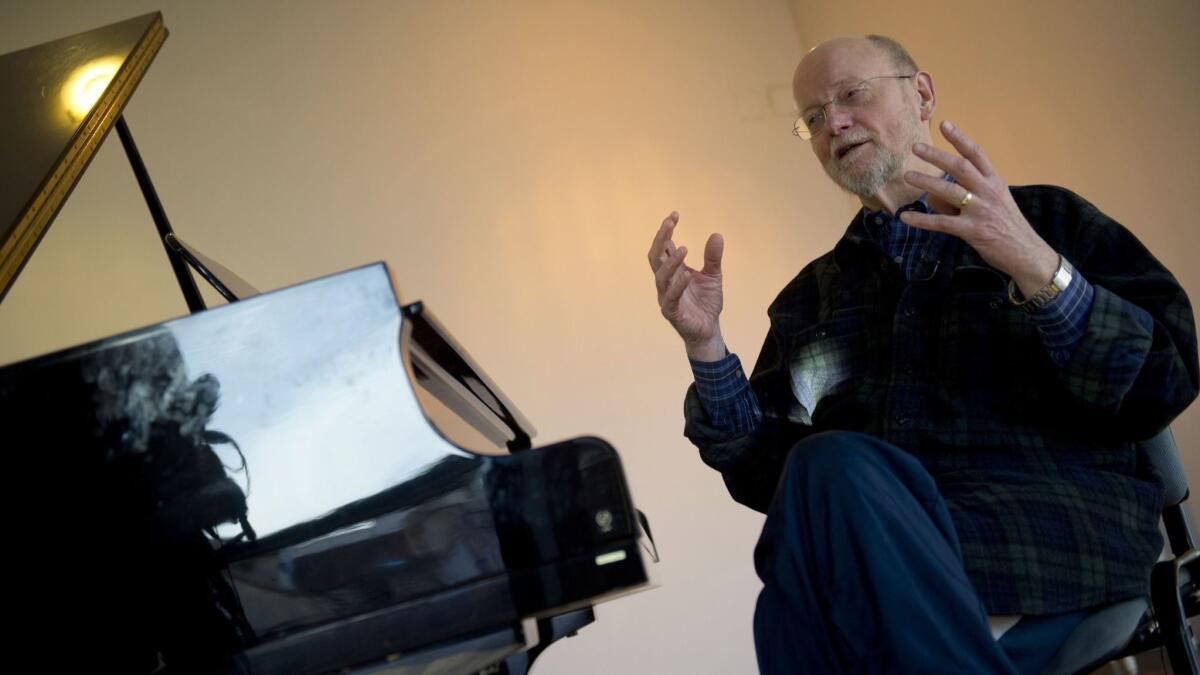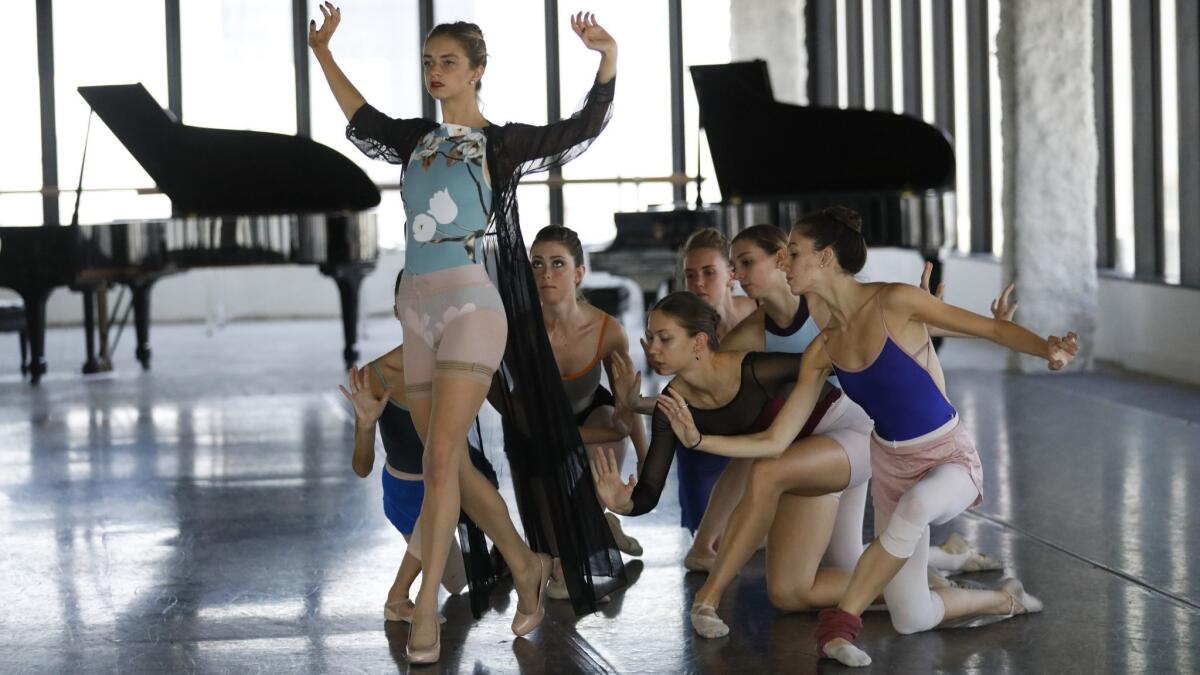âBurlesque,â a new Lincoln Jones ballet, a new collaboration with Charles Wuorinen and why it works

Lincoln Jones hopped off a skateboard and hurried toward afternoon rehearsal.
His dancers, dressed in black and wearing heels, waited along a window near a laptop that played the score of âBurlesque,â Jonesâ new work for his American Contemporary Ballet. A head turned. A leg arched. An arm unfurled and fluttered. The dancers moved as if shadows slipping slyly against the skyline, where, Jones said, he wanted âfeminine glamour to meet the tension within.â
âBurlesqueâ is the choreographerâs latest journey into the erotic, a terrain where classical form plays with temptation and the allure of beauty. Jones commissioned the score from Charles Wuorinen, the Pultizer Prize-winning composer known for his cerebral, 12-tone modernist style. Jones had wanted an original work from Wuorinen since his ballet company performed the composerâs âInfernoâ this time last year.
Jones has re-imagined parts of âInfernoâ and paired it with âBurlesque,â a double bill that opens the companyâs eighth season Friday. The collaboration between the choreographer and composer â commissioned ballet scores are rare these days â is an exploration of Wuorinenâs intricate flights and Jonesâ blend of past and present, earthen and dreamlike. The works, which conjure Danteâs version of hell and a red-light trip into the alleys of art and the libido, fittingly arrive the same month as Halloween.
His skateboard stowed, Jones wandered through rehearsal, counting out beats, consulting the score and breaking off alone, head down, reworking steps. He is a consummate tinkerer, tapping, soft-shoeing, a man adrift in bars and meters. The dancers, twirling against windows 32 floors above downtown in the companyâs studio, seemed as if slender, dark banners blowing across the horizon.
âThis music takes me to a new place in body and mind,â said Theresa Farrell, a dancer and executive director of American Contemporary Ballet. âYou have to listen to the changes in notes and meters. Itâs not always obvious like the swell of Tchaikovsky. The rhythms are more complex. Thereâs depth to it. This darkness and sexuality. It lets me speak with my body.â
A perfect collaboration between physical motion on the stage and musical motion in the pit is that neither compromises the integrity of the other.
— Charles Wuorinen
The following are edited excerpts from conversations with Jones, who moved his company here from New York in 2011, and Wuorinen, who has written more than 270 compositions, including âBrokeback Mountain,â an opera based on Annie Proulxâs tragic story of two gay cowboy lovers.

Lincoln, where did the idea for âBurlesqueâ come from?
Jones: Itâs had a long evolution. Iâve always been attracted to the relationship between popular and classical forms. Thereâs been a resurgence of burlesque, and a lot of it has that bump-and-grind and swing feel to it. But in the 1950s and â60s, burlesque was a series of tiny skits. I wanted to see what I could do with professional ballet dancers in skits that I hadnât seen before. What seized me was the idea of solo female performers exhibiting more than just skin. Thatâs whatâs happening in really good burlesque. You get a personality. How could I use that to display something more, and something that has more substance to it musically and compositionally?
What kind of music were you looking for, Lincoln? And, Charles, how did you approach the project?
Jones: If Charlesâ music was a topographical map, thereâs a lot there, and it lends itself to a lot of potential movement and meaning conveyed in sculptural form in a progression of events. I wanted Charles to write music for this to take the conventions of burlesque and distill and amplify them. The commissioning of ballet was common in Tchaikovskyâs time but is rare today. George Balanchine of course did it with composer Igor Stravinsky. Itâs the most exciting process. You get to create something from scratch. You can plant an idea in a composerâs head.
Wuorinen: Iâm not terribly interested in narrative dances, although I did make a three-ballet series derived from the âDivine Comedy.â Those didnât tell a story or try to represent the narrative, but rather to refer to various aspects of it in a symbolic way. Thatâs the way I approached this. I want to make a coherent musical statement. My concern is to try and absorb a generality of ideas presented to me and then go and write my piece.
Itâs written for two pianos. Why?
Wuorinen: A practical matter. There werenât unlimited resources for lots of instruments. It seemed to me that two pianos â the instruments are readily available â offer coverage of the complete range of all instruments. One isnât constrained in any way.

America has long had a curious relationship with sexuality. Itâs been closeted, exploited, celebrated. The early days of burlesque were an indication of that. Weâre now in a #MeToo era that emphasizes protecting women against harassment and exploitation. How does âBurlesqueâ fit into this?
Jones: Itâs an opportunity to explore the power of the female and feminine sexuality and eroticism. So often when that is done, because of perhaps our innate Puritanism that comes from our history, thereâs a dichotomy. And when sexuality or the erotic are dealt with, they are [portrayed] as separate things as opposed to being integrated into the whole. But it should be integrated and not seen as something separate.
Charles, one of the dancers in âBurlesqueâ says your music is complex and demanding but that it takes her to different and unexpected places.
Wuorinen: Thatâs what we want. We donât want to wrap people in a comfort blanket. We donât want to be mean or challenge them unnecessarily. But the whole purpose of doing this activity whatever the art may be is to try and elevate and expand perception and sensibility. Unfortunately, with a lot of mainstream performing institutions thereâs an awful lot of comfort blanket stuff. I donât have anything against it, but it shouldnât be the only thing or be the standard by which everything else is evaluated.

Lincoln, youâre a student of musical history and Charles is an exacting composer. What was your collaboration like?
Jones: Charles is a lot smarter than me, but I felt a real artistic sympathy with him right from the beginning. Heâs got a voracious mind and is very informed about what he does. I knew this was somebody I wanted to work with.
Wuorinen: Lincoln and I met two or three years ago in New York, and we discussed various ideas for collaboration. He was well-versed musically, and he had a degree of sophistication that not everyone in the dance world possesses.
What are the challenges of working with Charlesâ musical structures?
Jones: Itâs harder to memorize [laughs]. The meter changes, but also heâs got so many voices going. For the dancers, there are constant changes of bar lengths of three-four, four-four, seven-four, three-eight or whatever it may be. But there are also trickier things, like quintuplet in one voice against two triplets in the other traveling over a bar of four-four. Itâs very complex. I am up for it, but it can still be daunting. One of my goals is to get as many scores out of Charles as I can. Heâs attentive to the fact that in dance a gesture can only be so long. I [contrast] what he does with what Philip Glass does. He creates atmospheric soundscapes.
Charles, what impact did the ballets of Balanchine and Stravinsky have on you?
Wuorinen: One always looks to Balanchine as I suppose the greatest choreographer of the 20th century. Some of his projects were very daring. I was [also] very influenced as everyone was of my generation with Stravinsky. I was present at the very first performance of [Balanchine and Stravinskyâs collaboration] âAgonâ when it first went up at the City Center in New York. I still retain after [61] years, certain visual memories of the stage and certain striking things that Balanchine did. For me the epitome of a perfect collaboration between physical motion on the stage and musical motion in the pit is that neither compromises the integrity of nor detracts from the other.
âBurlesqueâ and âInfernoâ
Who: American Contemporary Ballet
Where: The Bloc, 700 S. Flower St., Suite 3200 (enter at 750 W. 7th St.), Los Angeles
When: Friday and Saturday nights, Oct. 12-27, plus two Halloween performances on Oct 31
Tickets: $45-$90 Oct. 13-31; $200-$500 Oct. 12 (opening night)
Info: (213) 878-9020, acbdances.com
See the most-read stories this hour Âť
Twitter: @JeffreyLAT
ALSO
More to Read
The biggest entertainment stories
Get our big stories about Hollywood, film, television, music, arts, culture and more right in your inbox as soon as they publish.
You may occasionally receive promotional content from the Los Angeles Times.











